Simulation of Urban Heat Island during a High-Heat Event Using WRF Urban Canopy Models: A Case Study for Metro Manila
Abstract
:1. Introduction
2. Data and Methodology
2.1. Study Area
2.2. Meteorological Data
2.3. WRF Configuration
2.4. Updated Land-Use Data
2.5. Experimental Design
2.6. Model Evaluation
2.7. Calculation of Relative Humidity, Heat Index, and Relative Urban Heat Index
3. Results and Discussion
3.1. Comparison of Observed and Simulated Near-Surface Atmospheric Variables
3.1.1. 2 m Air Temperature
3.1.2. Diurnal Variation of Air Temperature
3.1.3. Relative Humidity
3.2. Urban Heat Island Intensity (UHII)
3.3. Air Temperature by Administrative District
3.4. Spatial Variation of Air Temperature in Metro Manila
3.5. Spatial Variation of Heat Index in Metro Manila
4. Conclusions
Author Contributions
Funding
Institutional Review Board Statement
Informed Consent Statement
Data Availability Statement
Conflicts of Interest
Appendix A
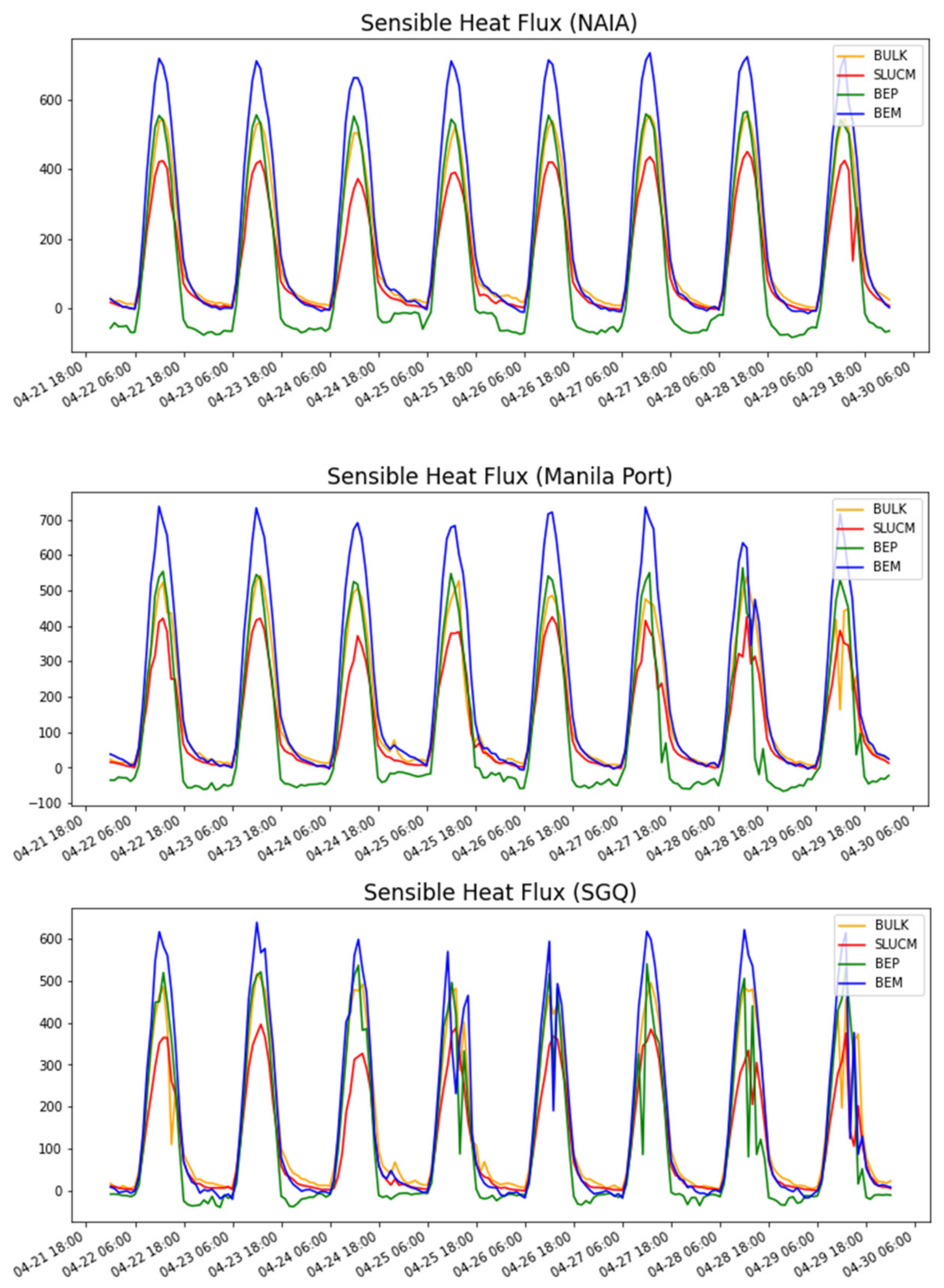
References
- UN-HABITAT. The State of the World’s Cities 2008-2009: Harmonious Cities; United Nation Centre for Human Settlements: Nairobi, Kenya, 2010; ISBN 978-92-1-132010-7. [Google Scholar]
- Navarro, A. Scrutinizing Urbanization Challenges in the Philippines through the Infrastructure Lens; Philippine Institute for Development Studies: Manila, Philippines, 2014. [Google Scholar]
- Angel, S.; Blei, A.; Lason-Hall, P.; Sanchez, N.G.; Gopalan, P.; Kallergis, A.; Civco, D.; Kumar, S.; Madrid, M.; Shingade, S.; et al. Atlas of Urban Expansion. Available online: http://atlasofurbanexpansion.org/cities/view/Manila. (accessed on 12 March 2020).
- Friedmann, J.; Sorensen, A. City Unbound: Emerging Mega-Conurbations in Asia. Int. Plan. Stud. 2019, 24, 1–12. [Google Scholar] [CrossRef] [Green Version]
- Oke, T. The Heat Island of the Urban Boundary Layer: Characteristics, Causes and Effects. NATO ASI Ser. E Appl. Sci. -Adv. Study Inst. 1995, 277, 81–108. [Google Scholar] [CrossRef]
- Wang, W.; Liu, K.; Tang, R.; Wang, S. Remote Sensing Image-Based Analysis of the Urban Heat Island Effect in Shenzhen, China. Phys. Chem. Earth Parts A/B/C 2019, 110, 168–175. [Google Scholar] [CrossRef]
- Keeratikasikorn, C.; Bonafoni, S. Urban Heat Island Analysis over the Land Use Zoning Plan of Bangkok by Means of Landsat 8 Imagery. Remote Sens. 2018, 10, 440. [Google Scholar] [CrossRef]
- Tiangco, M.; Lagmay, A.M.F.; Argete, J. ASTER-Based Study of the Night-Time Urban Heat Island Effect in Metro Manila. Int. J. Remote Sens. 2008, 29, 2799–2818. [Google Scholar] [CrossRef]
- Firozjaei, M.K.; Weng, Q.; Zhao, C.; Kiavarz, M.; Lu, L.; Alavipanah, S.K. Surface Anthropogenic Heat Islands in Six Megacities: An Assessment Based on a Triple-Source Surface Energy Balance Model. Remote Sens. Environ. 2020, 242, 111751. [Google Scholar] [CrossRef]
- Wang, X.; Huang, G.; Lin, Q.; Nie, X.; Liu, J. High-Resolution Temperature and Precipitation Projections over Ontario, Canada: A Coupled Dynamical-Statistical Approach. Q. J. R. Meteorol. Soc. 2014, 141, 1137–1146. [Google Scholar] [CrossRef]
- Wolters, D.; Brandsma, T. Estimating the Urban Heat Island in Residential Areas in the Netherlands Using Observations by Weather Amateurs. J. Appl. Meteorol. Climatol. 2012, 51, 711–721. [Google Scholar] [CrossRef]
- Manalo, J.A.; Matsumoto, J.; Takahashi, H.G.; Villafuerte, M.Q.; Olaguera, L.M.P.; Ren, G.; Cinco, T.A. The Effect of Urbanization on Temperature Indices in the Philippines. Int. J. Climatol. 2021, 1–18. [Google Scholar] [CrossRef]
- Hidayat, D.J.; Soekirno, S. Development of Temperature Monitoring and Prediction System for Urban Heat Island (UHI) Based on the Internet of Things. J. Phys. Conf. Ser. 2021, 1816, 12054. [Google Scholar] [CrossRef]
- Oh, J.W.; Ngarambe, J.; Duhirwe, P.N.; Yun, G.Y.; Santamouris, M. Using Deep-Learning to Forecast the Magnitude and Characteristics of Urban Heat Island in Seoul Korea. Sci. Rep. 2020, 10, 3559. [Google Scholar] [CrossRef] [Green Version]
- Skamarock, W.; Klemp, J.; Dudhia, J.; Gill, D.; Barker, D.; Duda, M.; Huang, X.; Wang, W. A Description of the Advanced Research WRF Version 3; University Corporation for Atmospheric Research: Boulder, CO, USA, 2008. [Google Scholar]
- Giannaros, T.M.; Melas, D.; Daglis, I.A. Numerical Study of the Urban Heat Island over Athens (Greece) with the WRF Model. Atmos. Environ. 2013, 73, 103–111. [Google Scholar] [CrossRef]
- Fallmann, J.; Emeis, S.; Suppan, P. Mitigation of Urban Heat Stress—A Modelling Case Study for the Area of Stuttgart. Erde 2013, 144, 202–216. [Google Scholar] [CrossRef]
- Chen, F.; Yang, X.; Zhu, W. WRF Simulations of Urban Heat Island under Hot-Weather Synoptic Conditions: The Case Study of Hangzhou City, China. Atmos. Res. 2014, 138, 364–377. [Google Scholar] [CrossRef]
- Bhati, S.; Mohan, M. WRF Model Evaluation for the Urban Heat Island Assessment under Varying Land Use/Land Cover and Reference Site Conditions. Theor. Appl. Climatol. 2016, 126, 385–400. [Google Scholar] [CrossRef]
- Deng, Q.; Zhou, Z. Measurement and Evaluation of the Microphysics and Boundary-Layer Schemes in Hot and Humid Zones in WRF Model. Environ. Prog. Sustain. Energy 2016, 1–7. [Google Scholar] [CrossRef]
- Segura, R.; Badia, A.; Ventura, S.; Gilabert, J.; Martilli, A.; Villalba, G. Sensitivity Study of PBL Schemes and Soil Initialization Using the WRF-BEP-BEM Model over a Mediterranean Coastal City. Urban Clim. 2021, 39, 100982. [Google Scholar] [CrossRef]
- Kusaka, H.; Kimura, F. Coupling a Single-Layer Urban Canopy Model with a Simple Atmospheric Model: Impact on Urban Heat Island Simulation for an Idealized Case. J. Meteorol. Soc. Japan 2004, 82, 67–80. [Google Scholar] [CrossRef] [Green Version]
- Kusaka, H.; Kondo, H.; Kikegawa, Y.; Kimura, F. A Simple Single Layer Urban Canopy Model for Atmospheric Models: Commparison with Multi-Layer and Slab Models. Bound.-Layer Meteorol. 2001, 101, 329–358. [Google Scholar] [CrossRef]
- Tewari, M.; Chen, F.; Dudhia, J.; LeMone, M.A.; Mitchell, K.E.; Ek, M.B.; Gayno, G.; Wegiel, J.; Cuenca, R. Implementation and Verifcation of the Unified NOAH Land Surface Model in the WRF Model. In Proceedings of the 20th Conference on Weather Analysis and Forecasting/16th Conference on Numerical Weather Prediction, Seattle, WA, USA, 11–15 January 2004; pp. 11–15. [Google Scholar]
- Salamanca, F.; Zhang, Y.; Barlage, M.; Chen, F.; Mahalov, A.; Miao, S. Evaluation of the WRF-Urban Modeling System Coupled to Noah and Noah-MP Land Surface Models Over a Semiarid Urban Environment. J. Geophys. Res. Atmos. 2018, 123, 2387–2408. [Google Scholar] [CrossRef]
- Salamanca, F.; Martilli, A.; Tewari, M.; Chen, F. A Study of the Urban Boundary Layer Using Different Urban Parameterizations and High-Resolution Urban Canopy Parameters with WRF. J. Appl. Meteorol. Climatol. 2011, 50, 1107–1128. [Google Scholar] [CrossRef]
- Cinco, T.A.; de Guzman, R.G.; Hilario, F.D.; Wilson, D.M. Long-Term Trends and Extremes in Observed Daily Precipitation and near Surface Air Temperature in the Philippines for the Period 1951-2010. Atmos. Res. 2014, 145–146, 12–26. [Google Scholar] [CrossRef]
- Bagtasa, G. 118-Year Climate and Extreme Weather Events of Metropolitan Manila in the Philippines. Int. J. Climatol. 2020, 40, 1228–1240. [Google Scholar] [CrossRef]
- Oliveros, J.M.; Vallar, E.A.; Galvez, M.C.D. Investigating the Effect of Urbanization on Weather Using the Weather Research and Forecasting (WRF) Model: A Case of Metro Manila, Philippines. Environ. MDPI 2019, 6, 10. [Google Scholar] [CrossRef] [Green Version]
- Estoque, R.C.; Ooba, M.; Seposo, X.T.; Togawa, T.; Hijioka, Y.; Takahashi, K.; Nakamura, S. Heat Health Risk Assessment in Philippine Cities Using Remotely Sensed Data and Social-Ecological Indicators. Nat. Commun. 2020, 11, 1–12. [Google Scholar] [CrossRef] [Green Version]
- Chen, F.; Kusaka, H.; Bornstein, R.; Ching, J.; Grimmond, C.S.B.; Grossman-Clarke, S.; Loridan, T.; Manning, K.W.; Martilli, A.; Miao, S.; et al. The Integrated WRF/Urban Modelling System: Development, Evaluation, and Applications to Urban Environmental Problems. Int. J. Climatol. 2011, 31, 273–288. [Google Scholar] [CrossRef]
- National Centers for Environmental Prediction, National Weather Service, NOAA, U.S. Department of Commerce, 2015: NCEP GDAS/FNL 0.25 Degree Global Tropospheric Analyses and Forecast Grids. Research Data Archive at the National Center for Atmospheric Research, Computational and Information Systems Laboratory, Boulder, Co. Available online: https://doi.org/10.5065/D65Q4T4Z (accessed on 20 January 2020).
- Malasig, J. It’s Getting Hot in Here: Manila’s “Extreme” Heat Index Level. Available online: https://interaksyon.philstar.com/breaking-news/2018/04/26/125543/extreme-heat-index-levels-manila-2018/ (accessed on 26 April 2018).
- Bougeault, P.; Lacarrere, P. Parameterization of Orography-Induced Turbulence in a Mesobeta–Scale Model. Mon. Weather Rev. 1989, 117, 1872–1890. [Google Scholar] [CrossRef]
- Jiménez, P.A.; Dudhia, J.; González-Rouco, J.F.; Navarro, J.; Montávez, J.P.; García-Bustamante, E. A Revised Scheme for the WRF Surface Layer Formulation. Mon. Weather Rev. 2012, 140, 898–918. [Google Scholar] [CrossRef] [Green Version]
- Mlawer, E.J.; Taubman, S.J.; Brown, P.D.; Iacono, M.J.; Clough, S.A. Radiative Transfer for Inhomogeneous Atmospheres: RRTM, a Validated Correlated-k Model for the Longwave. J. Geophys. Res. Atmos. 1997, 102, 16663–16682. [Google Scholar] [CrossRef] [Green Version]
- Dudhia, J. Numerical Study of Convection Observed during the Winter Monsoon Experiment Using a Mesoscale Two-Dimensional Model. J. Atmos. Sci. 1988, 46, 3077–3107. [Google Scholar] [CrossRef]
- Ek, M.B.; Mitchell, K.E.; Lin, Y.; Rogers, E.; Grunnmann, P.; Koren, V.; Gayno, G.; Tarpley, J.D. Implementation of NOAH Land Surface Model Advances in the NCEP Operational Mesoscale Eta Model. J. Geophys. Res. 2003, 108, 8851. [Google Scholar] [CrossRef]
- Kain, J.S. The Kain-Fritsch Convective Parameterization: An Update. J. Appl. Meteorol. 2004, 43, 170–181. [Google Scholar] [CrossRef]
- Tolentino, P.L.M.; Poortinga, A.; Kanamaru, H.; Keesstra, S.; Maroulis, J.; David, C.P.C.; Ritsema, C.J. Projected Impact of Climate Change on Hydrological Regimes in the Philippines. PLoS ONE 2016, 11, e0163941. [Google Scholar] [CrossRef] [PubMed] [Green Version]
- Garcia, J.A.; Vallar, E.; Galvez, M.C.; Bagtasa, G. Application of the WRF/Chem v.3.6.1 on the Reanalysis of Criteria Pollutants over Metro Manila. Sustain. Environ. Res. 2019, 1, 1–17. [Google Scholar] [CrossRef] [Green Version]
- Chen, G.; Zhao, L.; Mochida, A. Urban Heat Island Simulations in Guangzhou, China, Using the Coupled WRF/UCM Model with a Land Use Map Extracted from Remote Sensing Data. Sustainability 2016, 8, 628. [Google Scholar] [CrossRef] [Green Version]
- Lu, D.; Tian, H.; Zhou, G.; Ge, H. Regional Mapping of Human Settlements in Southeastern China with Multisensor Remotely Sensed Data. Remote Sens. Environ. 2008, 112, 3668–3679. [Google Scholar] [CrossRef]
- Li, X.; Zhao, L.; Li, D.; Xu, H. Mapping Urban Extent Using Luojia 1-01 Nighttime Light Imagery. Sensors 2018, 18, 3665. [Google Scholar] [CrossRef] [Green Version]
- Ma, T.; Xu, T.; Huang, L.; Zhou, A. Human Settlement Composite Index (HSCI) Derived from Nighttime Luminosity Associated with Imperviousness and Vegetation Indexes. Remote Sens. 2018, 10, 455. [Google Scholar] [CrossRef] [Green Version]
- Wang, R.; Wan, B.; Guo, Q.; Hu, M.; Zhou, S. Mapping Regional Urban Extent Using NPP-VIIRS DNB and MODIS NDVI Data. Remote Sens. 2017, 9, 862. [Google Scholar] [CrossRef] [Green Version]
- Friedl, M.; Sulla-Menashe, D. MCD12Q1 MODIS/Terra+Aqua Land Cover Type Yearly L3 Global 500m SIN Grud V006 2019. Available online: https://doi.org/10.5067/MODIS/MCD12Q1.006 (accessed on 16 January 2020).
- Nash, J.E.; Sutcliffe, J.V. River Flow Forecasting through Conceptual Models: Part I. A Discussion of Principles. J. Hydrol. 1970, 10, 282–290. [Google Scholar] [CrossRef]
- Carbonell, L.T.; Capote Mastrapa, G.; Fonseca Rodriguez, Y.; Alvarez Escudero, L.; Sanchez Gacita, M.; Bezanilla Morlot, A.; Borrajero Montejo, I.; Ruiz, E.M.; Pire Rivas, S. Assessment of the Weather Research and Forecasting Model Implementation in Cuba Addressed to Diagnostic Air Quality Modeling. Atmos. Pollut. Res. 2013, 4, 64–74. [Google Scholar] [CrossRef] [Green Version]
- Arasa, R.; Porras, I.; Domingo-Dalmau, A.; Picanyol, M.; Codina, B.; González, M.Á.; Piñón, J. Defining a Standard Methodology to Obtain Optimum WRF Configuration for Operational Forecast: Application over the Port of Huelva (Southern Spain). ACS 2016, 06, 329–350. [Google Scholar] [CrossRef] [Green Version]
- Alduchov, O.A.; Eskridge, R.E. Improved Magnus Form Approximation of Saturation Vapor Pressure. J. Appl. Meteorol. 1996, 35, 601–609. [Google Scholar] [CrossRef]
- Bolton, D. The Computation of Equivalent Potential Temperature. Mon. Weather Rev. 1980, 108, 1046–1053. [Google Scholar] [CrossRef]
- Rothfusz, L. The Heat Index Equation; Scientific Services Division: Fort Worth, TX, USA, 1990. Available online: https://www.weather.gov/media/ffc/ta_htindx.PDF (accessed on 5 February 2020).
- Chemel, C.; Sokhi, R. Response of London’s Urban Heat Island to a Marine Air Instrusion in an Easterly Wind Regime. Bound.-Layer Meteorol. 2012, 144, 65–81. [Google Scholar] [CrossRef] [Green Version]
- Sun, Y.; Zhang, N.; Miao, S.; Kong, F.; Zhang, Y.; Li, N. Urban Morphological Parameters of the Main Cities in China and Their Application in the WRF Model. J. Adv. Model. Earth Syst. 2021, 13, 1–20. [Google Scholar] [CrossRef]
- He, X.; Li, Y.; Wang, X.; Chen, L.; Yu, B.; Zhang, Y.; Miao, S. High-Resolution Dataset of Urban Canopy Parameters for Beijing and Its Application to the Integrated WRF/Urban Modelling System. J. Clean. Prod. 2019, 208, 373–383. [Google Scholar] [CrossRef]
- Li, D.; Bou-Zeid, E.; Baeck, M.; Jessup, S.; Smith, J. Modeling Land Surface Processes and Heavy Rainfall in Urban Environments: Sensitivity to Urban Surface Representations. J. Hydrometeorol. 2013, 14, 1098–1118. [Google Scholar] [CrossRef]
- Zhang, X.; Steeneveld, G.-J.; Zhou, D.; Ronda, R.J.; Duan, C.; Koopmans, S.; Holtslag, A.A.M. Modelling Urban Meteorology with Increasing Refinements for the Complex Morphology of a Typical Chinese City (Xi’an). Build. Environ. 2020, 182, 107109. [Google Scholar] [CrossRef]
- Silva, R.; Carvalho, A.C.; Carvalho, D. Study of Urban Heat Islands Using Different Urban Canopy Models and Identification Methods. Atmosphere 2021, 12, 521. [Google Scholar] [CrossRef]
- Salamanca, F.; Martilli, A.; Yagüe, C. A Numerical Study of the Urban Heat Island over Madrid during the DESIREX (2008) Campaign with WRF and an Evaluation of Simple Mitigation Strategies. Int. J. Climatol. 2012, 32, 2372–2386. [Google Scholar] [CrossRef]
- Dado, J.M.; Narisma, G. The Effect of Urban Expansion in Metro Manila on the Southwest Monsoon Rainfall. Asia-Pac. J. Atmos. Sci. 2019, 58, 1–12. [Google Scholar] [CrossRef]
- Gohil, K.; Jin, M.S. Validation and Improvement of the WRF Building Environment Parametrization (BEP) Urban Scheme. Climate 2019, 7, 109. [Google Scholar] [CrossRef] [Green Version]
- Jain, S.; Panda, J.; Rath, S.; Devara, P. Evaluating Land Surface Models in WRF Simulations over DMIC Region. Indian J. Sci. Technol. 2017, 10, 1–24. [Google Scholar] [CrossRef]
- Manalo, J.A.; Matsumoto, J.; Nodzu, M.I.; Olaguera, L.M.P. Diurnal Variability of Urban Heat Island Intensity: A Case Study of Metro Manila, Philippines. Geogr. Rep. Tokyo Metrop. Univ. 2022, 57, 13–22. [Google Scholar]
- Oliveira, A.; Lopes, A.; Correia, E.; Niza, S.; Soares, A. Heatwaves and Summer Urban Heat Islands: A Daily Cycle Approach to Unveil the Urban Thermal Signal Changes in Lisbon, Portugal. Atmosphere 2021, 12, 292. [Google Scholar] [CrossRef]
- Li, X.; Koh, T.; Panda, J.; Norford, L.K. Impact of Urbanization Patterns on the Local Climate of a Tropical City, Singapore: An Ensemble Study. J. Geophys. Res. Atmos. 2016, 121, 4386–4403. [Google Scholar] [CrossRef] [Green Version]
- Li, X.-X.; Koh, T.-Y.; Entekhabi, D.; Roth, M.; Panda, J.; Norford, L.K. A Multi-Resolution Ensemble Study of a Tropical Urban Environment and Its Interactions with the Background Regional Atmosphere: STUDY OF TROPICAL URBAN ENVIRONMENT. J. Geophys. Res. Atmos. 2013, 118, 9804–9818. [Google Scholar] [CrossRef]
- Soltani, A.; Sharifi, E. Daily Variation of Urban Heat Island Effect and Its Correlations to Urban Greenery: A Case Study of Adelaide. Front. Archit. Res. 2017, 6, 529–538. [Google Scholar] [CrossRef]
- Theeuwes, N.; Steeneveld, G.-J.; Ronda, R.J.; Rotach, M.; Holtslag, B. Cool City Mornings by Urban Heat. Environ. Res. Lett. 2015, 10, 4022. [Google Scholar] [CrossRef]
- Gonçalves, A.; Ornellas, G.; Castro Ribeiro, A.; Maia, F.; Rocha, A.; Feliciano, M. Urban Cold and Heat Island in the City of Bragança (Portugal). Climate 2018, 6, 70. [Google Scholar] [CrossRef]
- Conry, P.; Sharma, A.; Potosnak, M.J.; Leo, L.S.; Bensman, E.; Hellmann, J.J.; Fernando, H.J.S. Chicago’s Heat Island and Climate Change: Bridging the Scales via Dynamical Downscaling. J. Appl. Meteorol. Climatol. 2015, 54, 1430–1448. [Google Scholar] [CrossRef]
- Theeuwes, N.E.; Solcerová, A.; Steeneveld, G.J. Modeling the Influence of Open Water Surfaces on the Summertime Temperature and Thermal Comfort in the City. J. Geophys. Res. Atmos. 2013, 118, 8881–8896. [Google Scholar] [CrossRef] [Green Version]
- Stewart, I.D.; Oke, T.R. Local Climate Zones for Urban Temperature Studies. Bull. Am. Meteorol. Soc. 2012, 93, 1879–1900. [Google Scholar] [CrossRef]
- Mughal, M.O.; Li, X.X.; Yin, T.; Martilli, A.; Brousse, O.; Dissegna, M.A.; Norford, L.K. High-Resolution, Multilayer Modeling of Singapore’s Urban Climate Incorporating Local Climate Zones. J. Geophys. Res. Atmos. 2019, 124, 7764–7785. [Google Scholar] [CrossRef]
- Deng, Q.; Zhou, Z.; Shan, X.; Li, C.; Liu, D. Effects of Greening Areas and Water Bodies on Urban Microclimate in Wuhan—A Simulation Study Considering Prospective Planning. Atmosphere 2022, 13, 725. [Google Scholar] [CrossRef]
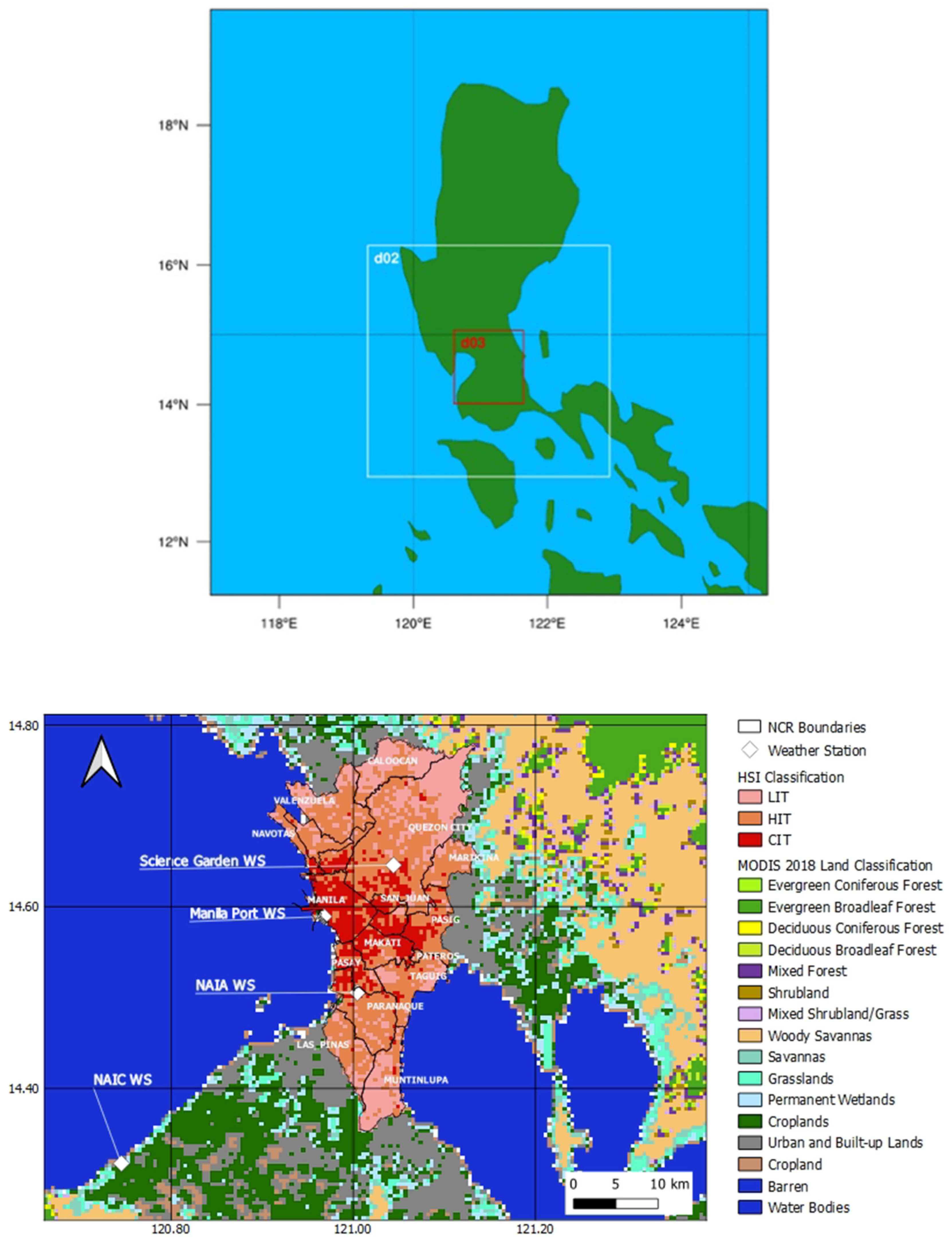

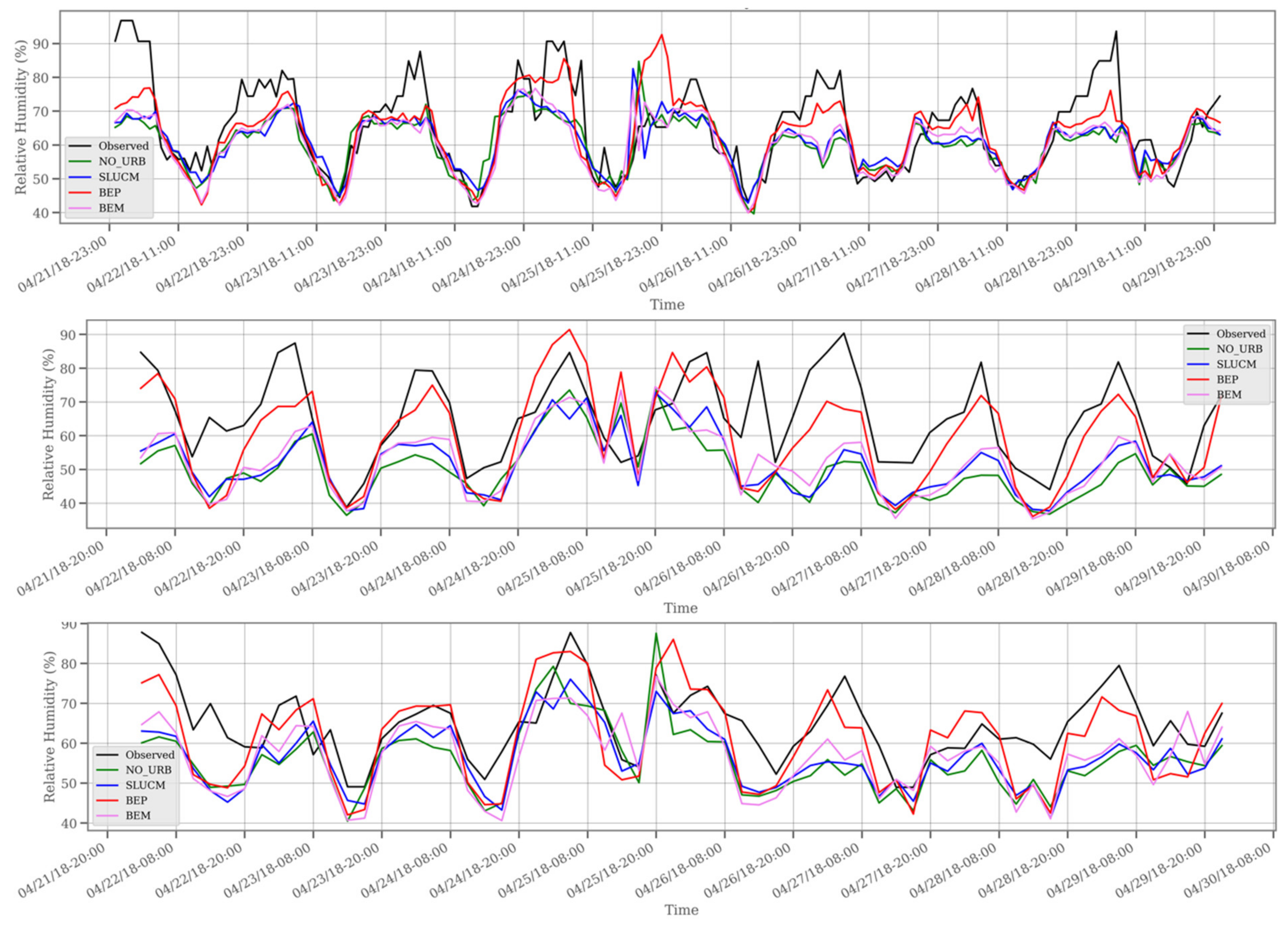
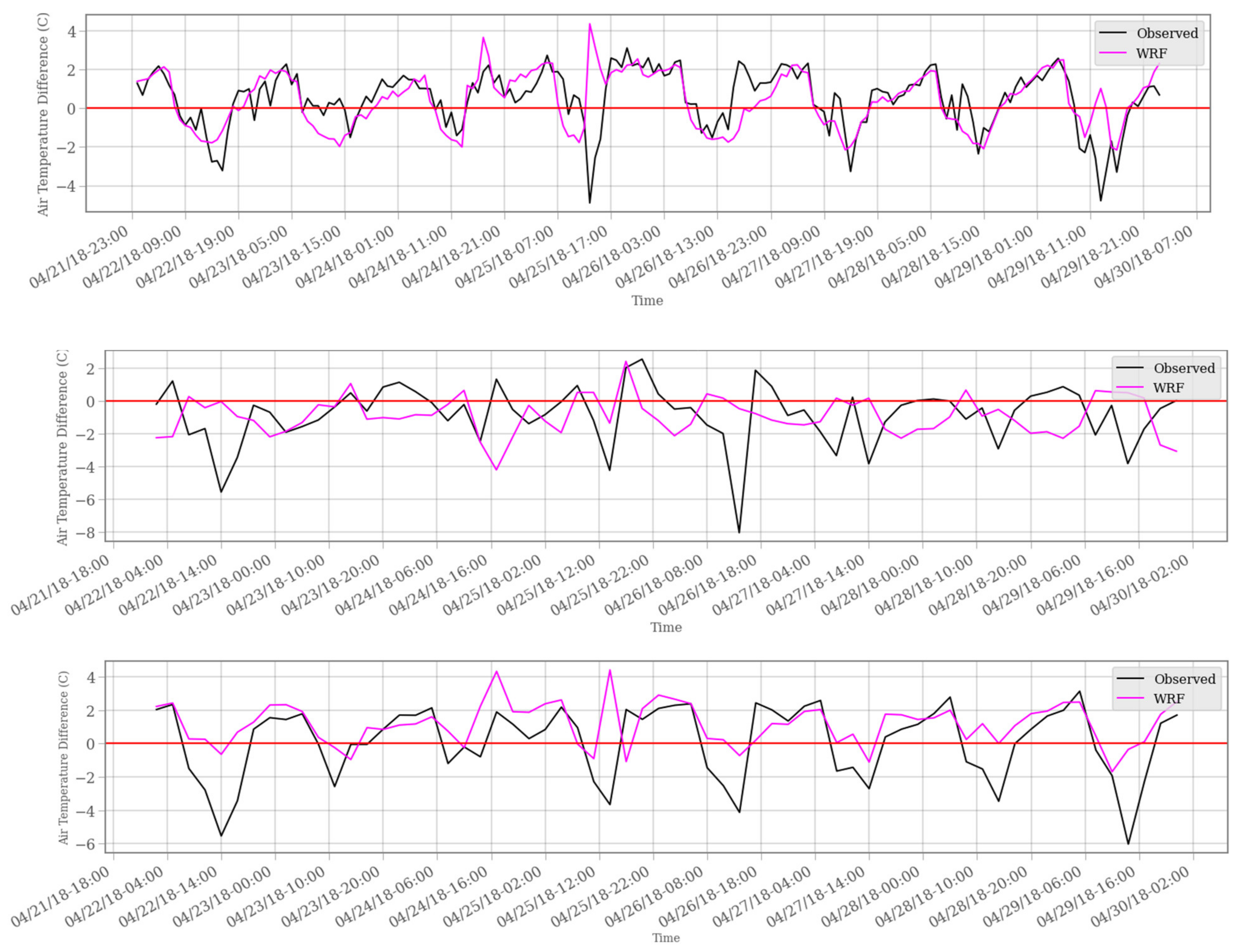
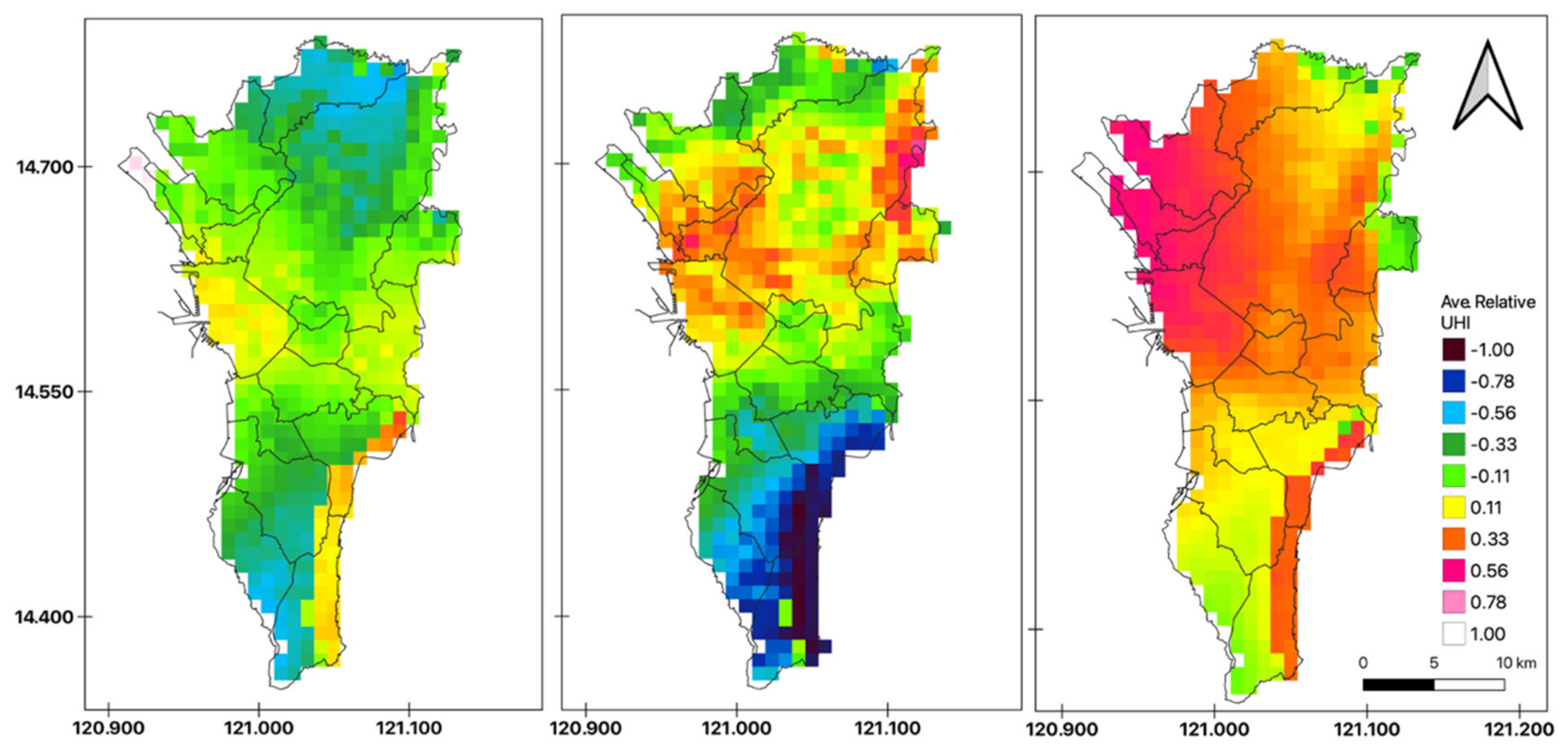
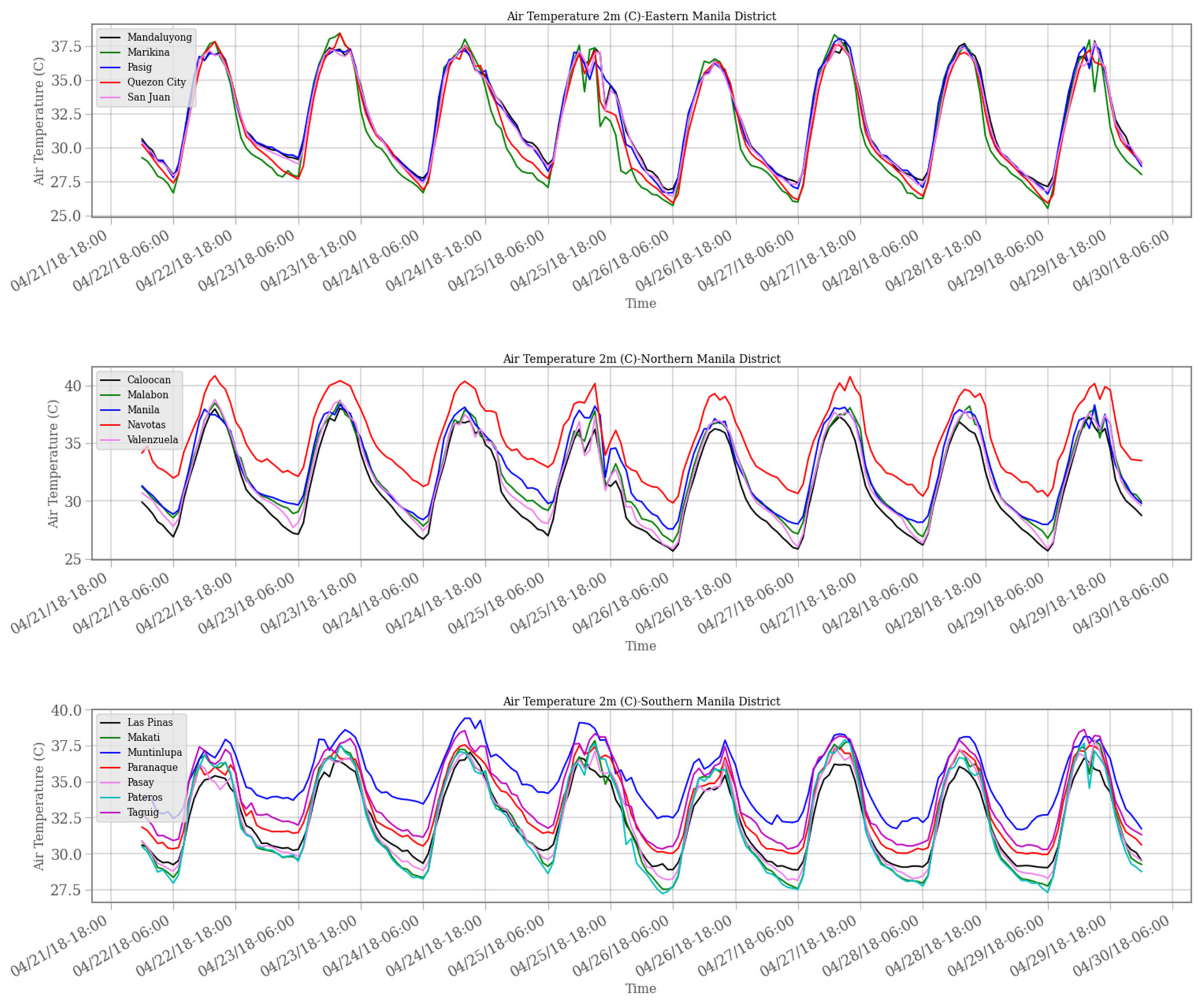
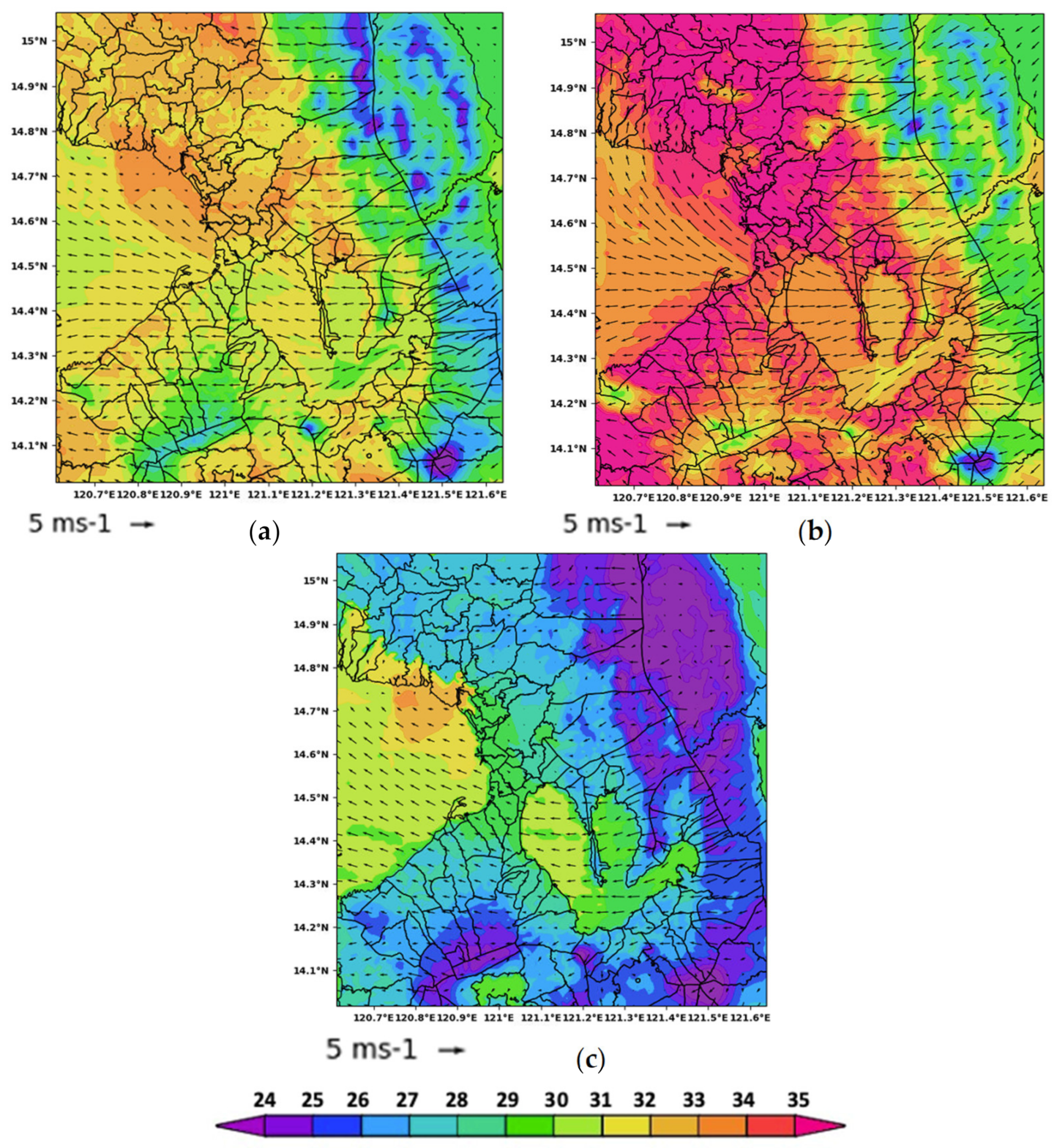
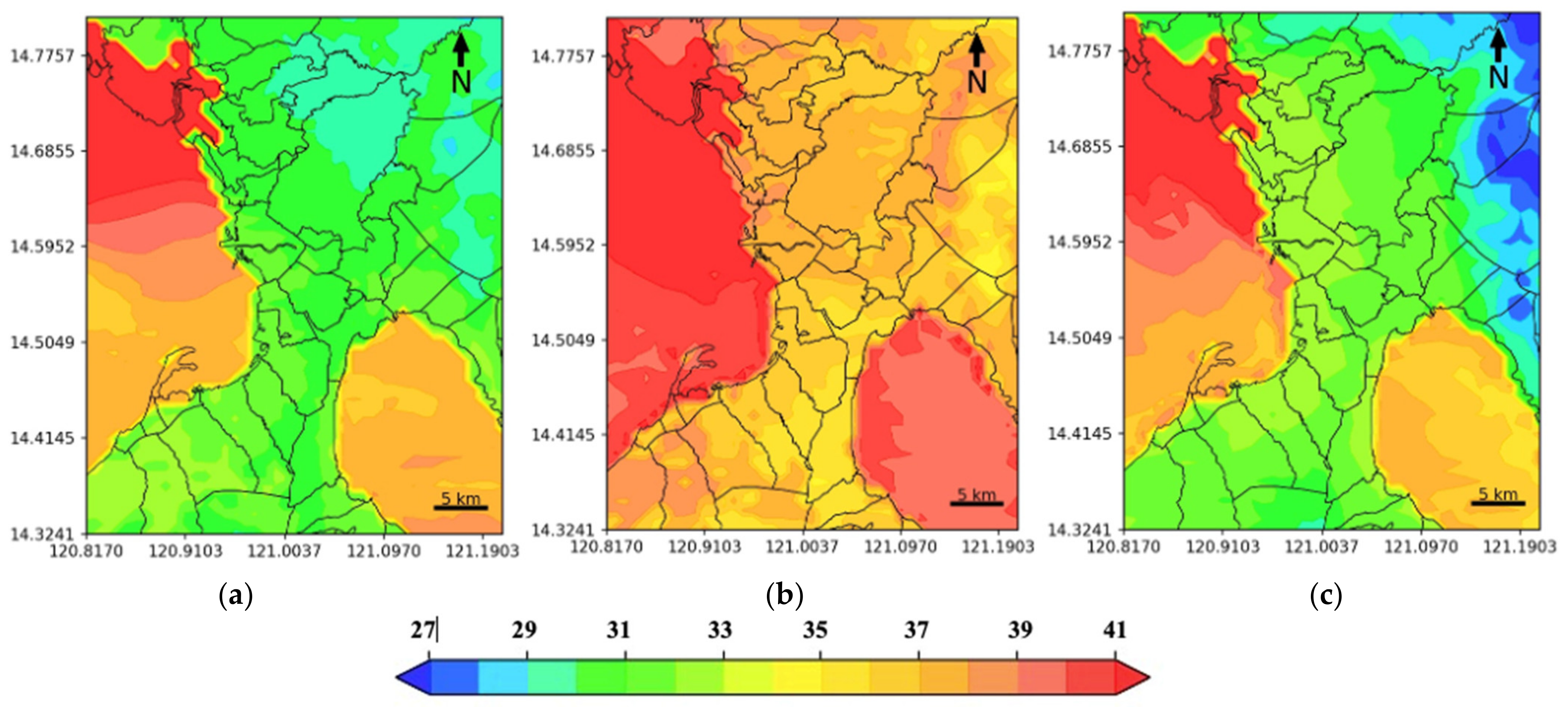
| Observation Station | Location | Temporal Resolution | HSI/Land Use Category Location |
|---|---|---|---|
| Manila Port Area, Manila | 14.59, 120.97 | 3-hourly | (3-Commercial/Industrial/Transportation) |
| Science Garden, Quezon City | 14.65, 121.04 | 3-hourly | (2-High Intensity Residential) |
| NAIA, Pasay City | 14.50, 121.00 | hourly | (3-Commercial/Industrial/Transportation) |
| Naic, Cavite (Rural) | 14.32, 120.75 | hourly | Cropland |
| WRF Model | WRF V3.9 | |
|---|---|---|
| WRF Dynamical Solver | ARW | |
| Domain Grid Spacing | D01: dx = 9000 m, dy = 9000 m D02: dx = 3000 m, dy = 3000 m D03: dx = 1000 m, dy = 1000 m | |
| Land Use | MODIS 2018 data from LPDAAC data set with a spatial resolution of 30′. | |
| Initial Meteorological Data | NCEP GDAS/FNL Operational Model Global Tropospheric Analyses Spatial Resolution = 0.25° Temporal Resolution = 6 h | |
| Vertical Levels | 40 with 16 levels below 1 km | |
| eta_levels = | 1.000, 0.9986, 0.9972, 0.9958, 0.9943, | |
| 0.9929, 0.9915, 0.9901, 0.9887, 0.9873, | ||
| 0.9859, 0.9845, 0.9824, 0.9792, 0.9749, | ||
| 0.9688, 0.9606, 0.9497, 0.9353, 0.9169, | ||
| 0.8935, 0.8646, 0.8296, 0.7884, 0.7412, | ||
| 0.6887, 0.632, 0.5724, 0.5115, 0.4506, | ||
| 0.3909, 0.3336, 0.2792, 0.2283, 0.1812, | ||
| 0.1379, 0.0984, 0.0599, 0.0279, 0.000 | ||
| Physics Options | PBL: Boulac Scheme (BEP/BEM) Surface Layer: Revised MM5 Land Surface Model: NOAH LSM Longwave/Shortwave: RRTM/Dudhia Cumulus: Kain-Frisch (0 for d03) Microphysics: WRF Single Moment 3 (WSM3) | |
| Variable | Evaluation Parameter | Criteria |
|---|---|---|
| Temperature—2 m | RMSE MAE Mean Bias IOA | ≤3.5 °C ≤2.0 °C ≤±2.0 °C ≥0.8 |
| Relative Humidity—2 m | RMSE Mean Bias IOA | ≤8.5% ≤±10.0% ≥0.60 |
| Experimental Design | RMSE (°C) | MAE (°C) | Bias (°C) | IOA | NSE |
|---|---|---|---|---|---|
| NAIA, Pasay City | |||||
| NO_URB | 1.40 | 1.15 | −0.91 | 0.90 | 0.69 |
| SLUCM | 1.56 | 1.30 | −1.07 | 0.88 | 0.61 |
| BEP | 1.80 | 1.59 | −1.50 | 0.89 | 0.48 |
| BEM | 1.21 | 0.99 | −0.79 | 0.94 | 0.76 |
| Manila Port Area, Manila | |||||
| NO_URB | 0.98 | 0.68 | −0.09 | 0.94 | 0.76 |
| SLUCM | 1.13 | 0.82 | −0.33 | 0.92 | 0.68 |
| BEP | 2.09 | 1.72 | −1.28 | 0.84 | −0.11 |
| BEM | 1.31 | 0.97 | −0.24 | 0.91 | 0.57 |
| Science Garden, Quezon City | |||||
| NO_URB | 2.46 | 1.95 | 1.56 | 0.79 | 0.35 |
| SLUCM | 2.06 | 1.67 | 1.01 | 0.86 | 0.52 |
| BEP | 2.41 | 1.84 | −0.82 | 0.88 | 0.35 |
| BEM | 2.10 | 1.73 | 0.91 | 0.86 | 0.50 |
| Experimental Design | RMSE (°C) | MAE (°C) | Bias (°C) | IOA | NSE | |||||
|---|---|---|---|---|---|---|---|---|---|---|
| D | N | D | N | D | N | D | N | D | N | |
| NAIA, Pasay City | ||||||||||
| NO_URB | 1.57 | 1.23 | 1.43 | 0.91 | 1.57 | −0.56 | 0.82 | 0.73 | 0.23 | 0.29 |
| SLUCM | 1.80 | 1.30 | 1.67 | 0.89 | 1.80 | −0.64 | 0.78 | 0.73 | −0.01 | 0.20 |
| BEP | 1.68 | 1.88 | 1.52 | 1.64 | 1.68 | −1.62 | 0.83 | 0.68 | 0.12 | −0.67 |
| BEM | 1.27 | 1.14 | 1.12 | 0.88 | 1.29 | −0.75 | 0.88 | 0.80 | 0.48 | 0.38 |
| Manila Port Area, Manila | ||||||||||
| NO_URB | 1.08 | 0.87 | 0.83 | 0.53 | −0.16 | −0.01 | 0.91 | 0.81 | 0.59 | 0.31 |
| SLUCM | 1.33 | 0.90 | 1.03 | 0.61 | −0.44 | −0.22 | 0.87 | 0.83 | 0.38 | 0.26 |
| BEP | 2.08 | 2.11 | 1.51 | 1.93 | −0.63 | −1.93 | 0.80 | 0.58 | −0.52 | −3.1 |
| BEM | 1.73 | 0.67 | 1.37 | 0.57 | −0.20 | −0.27 | 0.82 | 0.91 | −0.05 | 0.58 |
| Science Garden, Quezon City | ||||||||||
| NO_URB | 1.99 | 2.84 | 1.28 | 2.63 | 0.65 | 2.46 | 0.79 | 0.57 | −0.01 | −1.26 |
| SLUCM | 1.82 | 2.28 | 1.36 | 1.98 | 0.21 | 1.81 | 0.83 | 0.66 | 0.17 | −0.45 |
| BEP | 2.98 | 1.64 | 2.30 | 1.37 | −0.60 | −1.03 | 0.73 | 0.85 | −1.24 | 0.25 |
| BEM | 2.12 | 2.09 | 1.62 | 1.85 | 0.16 | 1.67 | 0.81 | 0.69 | −0.13 | −0.22 |
| Experimental Design | RMSE (%) | MAE (%) | Bias (%) | IOA | NSE |
|---|---|---|---|---|---|
| NAIA, Pasay City | |||||
| NO_URB | 10.3 | 7.55 | −5.13 | 0.75 | 0.35 |
| SLUCM | 10.0 | 7.22 | −4.24 | 0.75 | 0.40 |
| BEP | 8.46 | 6.13 | −2.21 | 0.86 | 0.57 |
| BEM | 9.82 | 7.02 | −5.35 | 0.80 | 0.42 |
| Manila Port Area, Manila | |||||
| NO_URB | 11.7 | 9.96 | −9.03 | 0.66 | −0.68 |
| SLUCM | 10.7 | 8.90 | −8.28 | 0.68 | −0.41 |
| BEP | 8.57 | 6.87 | −3.40 | 0.82 | 0.10 |
| BEM | 10.9 | 9.22 | −7.91 | 0.68 | −0.45 |
| Science Garden, Quezon City | |||||
| NO_URB | 19.2 | 16.1 | −15.3 | 0.56 | −1.23 |
| SLUCM | 17.2 | 14.0 | −13.4 | 0.60 | −0.80 |
| BEP | 11.3 | 8.86 | −5.23 | 0.82 | 0.22 |
| BEM | 16.6 | 13.8 | −12.7 | 0.62 | −0.67 |
Publisher’s Note: MDPI stays neutral with regard to jurisdictional claims in published maps and institutional affiliations. |
© 2022 by the authors. Licensee MDPI, Basel, Switzerland. This article is an open access article distributed under the terms and conditions of the Creative Commons Attribution (CC BY) license (https://creativecommons.org/licenses/by/4.0/).
Share and Cite
Bilang, R.G.J.P.; Blanco, A.C.; Santos, J.A.S.; Olaguera, L.M.P. Simulation of Urban Heat Island during a High-Heat Event Using WRF Urban Canopy Models: A Case Study for Metro Manila. Atmosphere 2022, 13, 1658. https://doi.org/10.3390/atmos13101658
Bilang RGJP, Blanco AC, Santos JAS, Olaguera LMP. Simulation of Urban Heat Island during a High-Heat Event Using WRF Urban Canopy Models: A Case Study for Metro Manila. Atmosphere. 2022; 13(10):1658. https://doi.org/10.3390/atmos13101658
Chicago/Turabian StyleBilang, Ronald Gil Joy P., Ariel C. Blanco, Justine Ace S. Santos, and Lyndon Mark P. Olaguera. 2022. "Simulation of Urban Heat Island during a High-Heat Event Using WRF Urban Canopy Models: A Case Study for Metro Manila" Atmosphere 13, no. 10: 1658. https://doi.org/10.3390/atmos13101658
APA StyleBilang, R. G. J. P., Blanco, A. C., Santos, J. A. S., & Olaguera, L. M. P. (2022). Simulation of Urban Heat Island during a High-Heat Event Using WRF Urban Canopy Models: A Case Study for Metro Manila. Atmosphere, 13(10), 1658. https://doi.org/10.3390/atmos13101658






